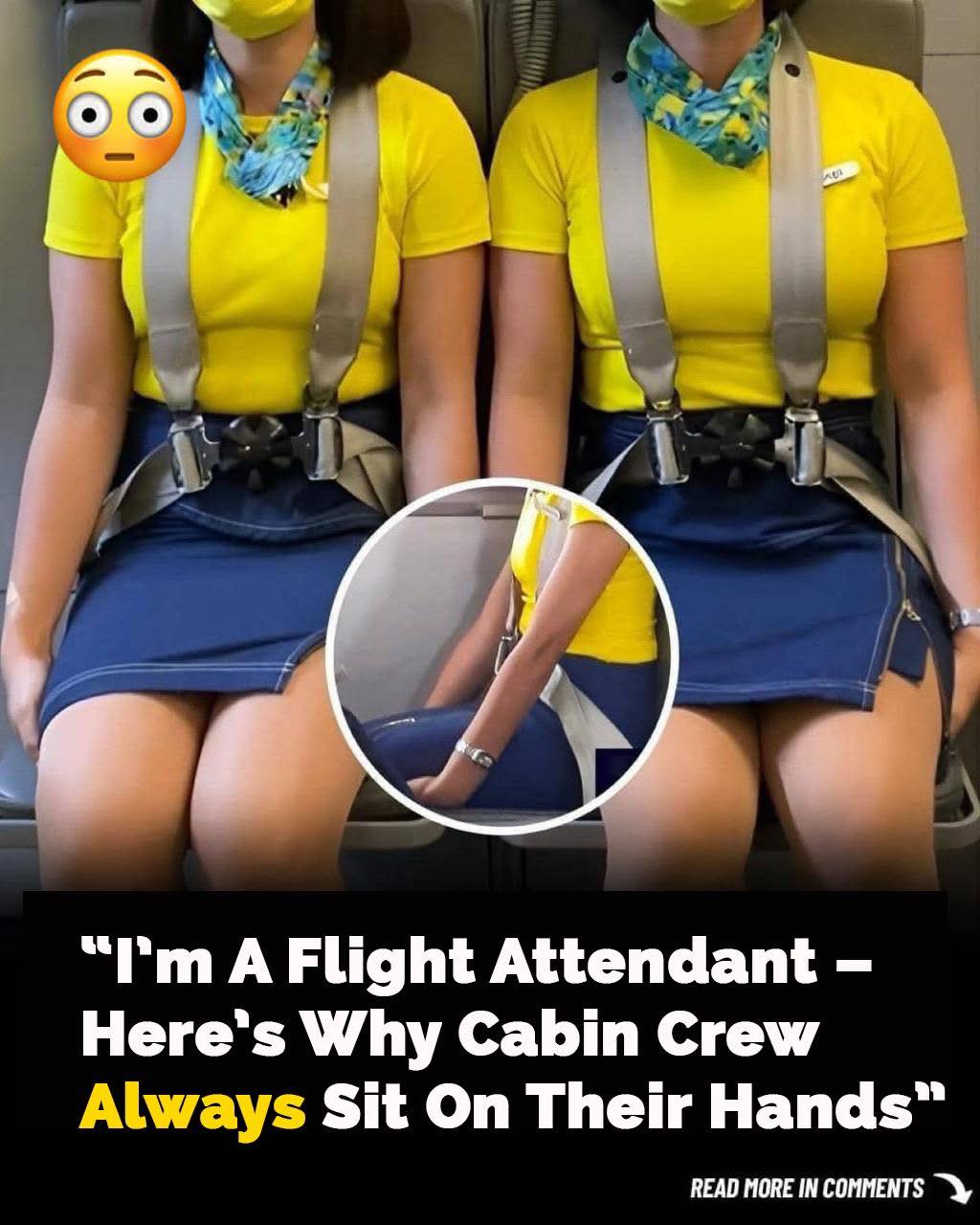If you’ve ever taken a commercial flight, you may have noticed something intriguing—flight attendants often sit on their hands during takeoff and landing. While this might seem like an odd habit, it’s actually an essential safety measure designed to protect both the crew and passengers. Flight attendants are far more than just service providers; they are highly trained professionals responsible for handling emergencies and ensuring the safety of everyone on board.

One specific safety procedure that frequently catches passengers’ attention is the bracing position that flight attendants assume during these critical phases of a flight. Recently, Cebu Pacific flight attendant Henny Lim shared a TikTok video explaining this little-known practice, which quickly gained traction. In the video, she asks, “Have you ever wondered why cabin crew adopts this position during takeoff and landing?” She then demonstrates the bracing position while seated in her jump seat.
Takeoff and landing are the most crucial moments of any flight, with a higher likelihood of incidents occurring during these times. If an emergency evacuation becomes necessary, the bracing position allows flight attendants to react swiftly and effectively. According to the video’s narration, the correct technique includes securing the seatbelt, sitting upright, tucking hands under the thighs, relaxing the arms, and keeping both feet flat on the floor. Though the video originally surfaced in 2022, it has recently regained popularity, bringing renewed attention to this important safety protocol.
In the demonstration, Henny and a fellow crew member show how they stabilize themselves by tucking their hands under their thighs. This technique is crucial because it keeps their arms and hands steady, preventing involuntary movements caused by turbulence, rough landings, or sudden jolts. By limiting movement, flight attendants minimize their risk of injury and can immediately assist passengers when needed. The video highlights that maintaining a rigid posture helps reduce the impact on the body during an emergency, ensuring that crew members are in the best possible condition to take action.
@_hennylim_ Why do cabin crew sit on their hands while in their jumpseats? Check this video out to know! Special guest for today’s video: Clare demecillo Follow my Official Facebook Page: “Henny Joyce Lim” Follow me on Instagram: _hennylim_ #fyp #HJL #cabincrewlife #bracingposition #cebupacific #groundstop ♬ Aesthetic – Tollan Kim
Additionally, during takeoff and landing, flight attendants conduct a “silent review,” a mental checklist that helps them prepare for potential emergencies. This practice ensures they are ready to act instantly without hesitation. As the video concludes, a final reassuring message plays: “Safe flight, everyone.”
Despite the widespread discussion about this practice, it’s important to clarify that sitting on one’s hands is not an official aviation regulation. A veteran flight attendant shared with Reader’s Digest that this practice is more of a personal preference than a formal rule. While the brace position itself is crucial, individual crew members can choose whether or not to sit on their hands. According to Erin Thomas, a flight attendant with over 15 years of experience, the key is to avoid gripping the harness, as this could lead to injuries. “The brace position is what really matters,” she explained.
Erin personally prefers to rest her hands on her lap, stating, “It helps me appear calm.” Since passengers often take cues from the flight crew, maintaining a composed and professional demeanor during takeoff and landing can help reassure travelers. While the stance may appear rigid, it plays a crucial role in preventing injuries and allowing crew members to respond quickly after an impact.
Understanding why flight attendants sit on their hands gives passengers valuable insight into the many safety measures in place during air travel. Every part of their training is designed to maximize safety and ensure they can respond effectively in any situation. The bracing position is not just about protecting themselves—it’s about being ready to assist passengers in case of an emergency.
Beyond their physical posture, flight attendants continuously assess their surroundings, monitoring passengers for potential issues. Their silent review during takeoff and landing includes mentally preparing for various emergency scenarios, reviewing evacuation procedures, and determining the best way to assist different types of passengers. This level of preparedness ensures they can act decisively and confidently if a crisis arises.
Sitting on their hands is a seemingly small but significant part of this preparation. By reducing their own movements, flight attendants minimize their risk of injury, allowing them to remain fully functional and ready to assist passengers. In high-stress situations, even a momentary delay can make a critical difference, making it essential for crew members to maintain a position that reduces the impact of sudden movements.
While not all airlines require flight attendants to sit on their hands, the practice has become a common choice among crew members worldwide. It reflects their commitment to prioritizing passenger safety and being prepared for any emergency that may arise. The next time you see a flight attendant assuming this position, you’ll know that it’s part of their dedication to ensuring a secure and comfortable flight experience for everyone on board.
So, have you ever wondered why flight attendants sit on their hands? Now that you understand the reasoning behind this practice, you can appreciate the level of care and preparation that goes into every flight. Whether through their bracing position, silent reviews, or calm demeanor, flight attendants play a crucial role in ensuring that passengers reach their destinations safely. The next time you fly, take a moment to recognize the dedication and expertise of the crew members who work tirelessly to keep you safe. Their readiness and ability to react quickly can make all the difference in an emergency. Safe travels, and trust the professionals who are there to ensure your journey is both smooth and secure.





